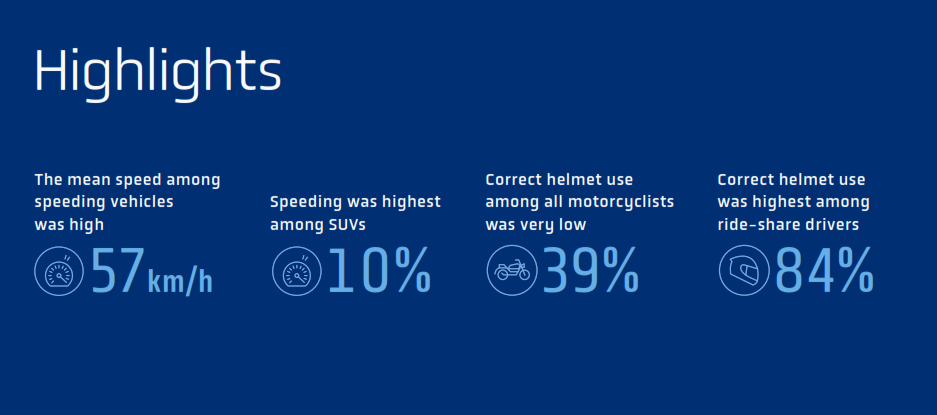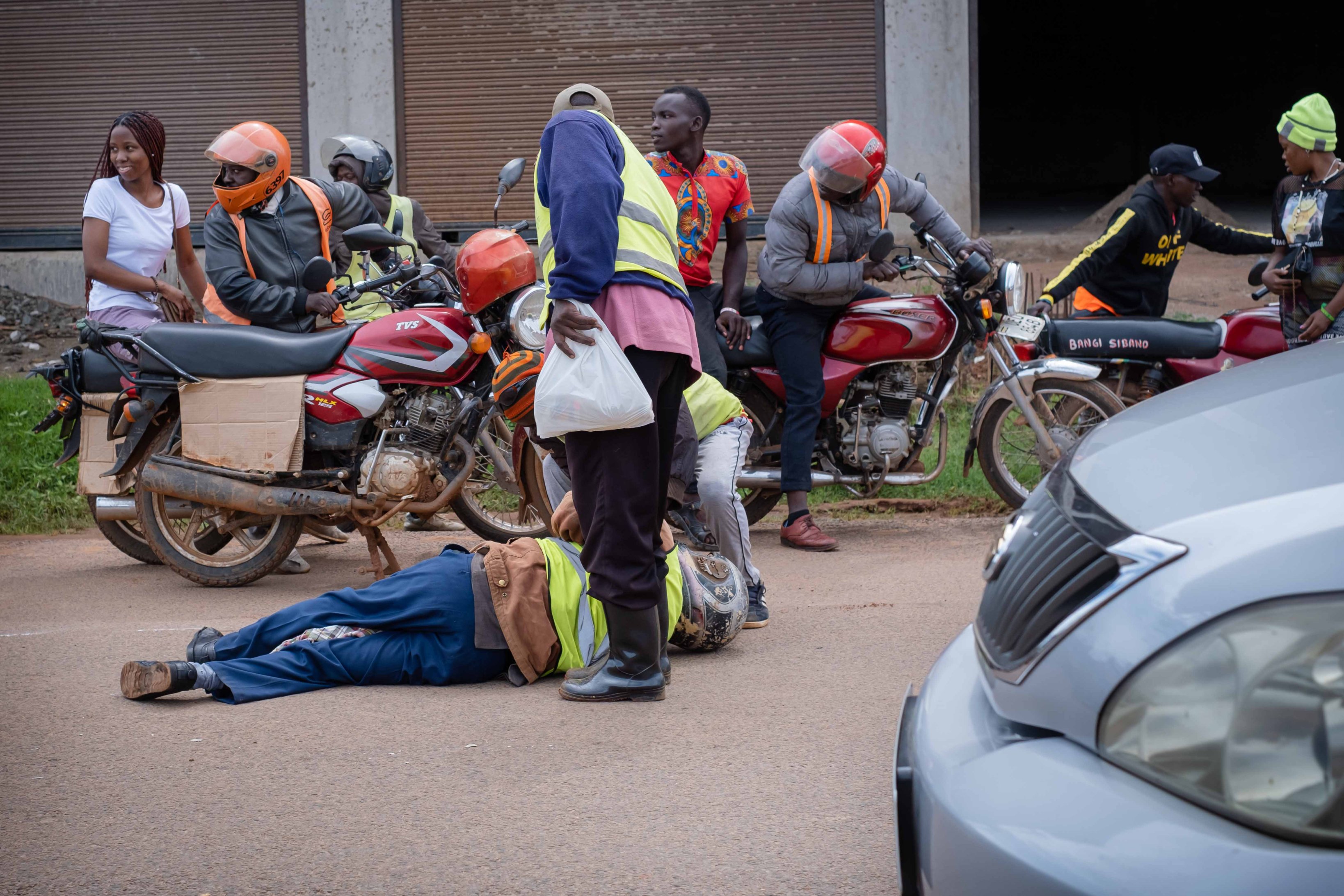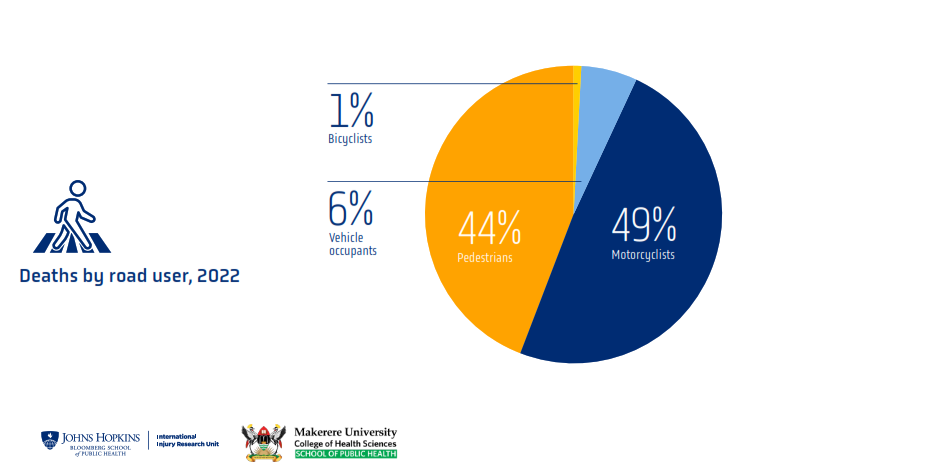
Makerere University School of Public Health (MakSPH) and the Johns Hopkins International Injury Research Unit (JH-IIRU) have launched the status summary report 2023; Road Risk Factors for Kampala, Uganda, in partnership with Kampala Capital City Authority (KCCA) and Vital Strategies.
Launched at Hotel Africana in Kampala on January 16, 2024, the report delineates key findings, including the average speed of speeding vehicles at a high average of 57km/hr, higher speeds on roads partially accessible to pedestrians compared to roads freely accessible to pedestrians. Also, helmet usage remains low among motorcyclists and is almost non-existent among passengers, contributing to a rise in accidents and fatalities since 2020.
There has been a variable trend in the reported numbers of deaths and serious injuries since 2018. Specifically, in 2022, there was a 1% increase in reported deaths compared to 2021, while serious injuries witnessed a 4% decrease during the same period.
In 2018, a total of 294 death were recorded, 315 recorded in 2019 while 236 were recorded in 2020. In 2021, there were 419 road traffic death and 425 recorded in 2022. Motorcyclists accounted for nearly half (49%) of the reported deaths followed by pedestrians who made up 44% of deaths. In a bid to improve road safety by providing quality data, the research supported by the Bloomberg Philanthropies Initiative for Global Road Safety (BIGRS) made roadside observations on speed and helmet use in Kampala City.
Six observation rounds citing 500,000 for speeding vehicles and 600,000 cyclists to determine helmet use were conducted between February 2021 and October 2023 and findings show the mean speed among speeding vehicles was high mostly among sport utility vehicles (SUVs) at 10%, sedans/saloons at 9%, minibuses/minivans at 8), and pickup/light trucks at 7%. Five percent of the observed vehicles were exceeding the posted speed limit.

Speeding in Kampala
Presenting findings, Mr. Bonny Balugaba, a Researcher based at the Trauma, Injuries and Trauma Unit of MakSPH noted that the international best practices for speed management recommend a safe speed of 30 km/h on roads where conflicts between cars and unprotected users are possible. Also, 50 km/h speed is recommended at intersections where side-on conflicts between cars may occur. This is particularly applicable in urban areas.
“If in Kampala we are seeing 57km/h speed, it means that we are way above the recommended speed limits and we know that beyond 40km/h, the chances of survival of someone that has been knocked are very minimal,” says Balugaba.
The researchers recommend enforcing a 50 km/h speed limit in metropolitan areas and a 30 km/h limit in places where motorized traffic interacts with bikes and pedestrians. In order to safeguard vulnerable road users, particularly the Ministry of Works and Transport and the Kampala Capital City Authority, it suggests implementing speed-calming techniques including bumps and signage as well as designating low-speed areas.
Investigators further advise the Kampala Metropolitan Traffic Police to increase enforcement, especially on local roads and on vehicles such as SUVs, sedans, pickup trucks, minibuses on routes with limited pedestrian access. It is recommended that public awareness campaigns and enforcement measures regarding the dangers of speeding be regularly monitored and evaluated to ensure continued efficacy.
Balugaba noted; “Mass media is good but if you are telling me the dangers of speed but am not apprehended on speed then it tends to entertainment. You come, entertain me with your campaign and adverts and go away but you are not enforcing.”

Helmet Use in Kampala
Helmet use compliance among motorcyclists was notably low at 39%, and even lower for passengers at 2%. This trend persisted on both local and collector roads (39%) and arterial roads (40%). During weekends, helmet use dropped by 20%. Ride-share motorcycle drivers, particularly Safe Boda, exhibited the highest compliance at 84%, surpassing commercial motorcycle drivers (50%), taxi drivers (55%), and private/government motorcycle users (55%).
From 2020 to 2022, 210 motorcycle occupants and 185 pedestrians lost their lives. Notably, 40% of pedestrian fatalities resulted from collisions with cars, SUVs, or pickups, whereas 36% of motorcycle deaths were attributed to accidents involving other motorcycles.

“We saw that only 2% of the motorcycles are using helmets. This really means that the situation is still bad. We need to put in place measures knowing that helmets save those that are wearing them,” says Balugaba.
While four of every 10 riders are wearing a helmet, that less than one in every 10 passengers has a helmet. “Is it that passengers have harder heads than riders? That in case they are involved in a crash, they don’t get affected? These are issues we need to work on,” wondered Mr. Balugaba.
While sharing the data outcomes, Dr Raphael Awuah, the African Regional Advisor on Data and Surveillance for Vital Strategies noted that while many of the cities in Africa, pedestrians constitute the majority fatalities, this is different for Kampala. “For most parts of Africa, we see that pedestrians account for most fatalities. However, in Kampala, this is not the case. We see that majority of the deaths are among the motorcyclists and this trend has been observed since 2018. So clearly this emphasizes the need to prioritize the vulnerable road users in Kampala particularly motorcyclists and pedestrians.”

The top five locations for pedestrian fatalities and serious injuries from 2019 to 2022 are high-capacity roads: Kampala Road, Jinja Road, Bombo Road, Entebbe Road, and Masaka Road.
While the distribution of motorcycle fatal crash locations does not exhibit any clear pattern, there is a noticeable concentration on high-capacity highways. Kampala Road, Masaka Road, Bombo Road, Kisaasi Road, and the Northern Bypass are the top five places.
“While it is true that these are high capacity roads, speeding is probably one of the causes of fatalities. I hope we will use this data to inform the discussions, actions, plans, strategies to reduce the outcomes that I have just shared,” observed Dr Raphael Awuah.
The Kampala Metropolitan Traffic Police has been asked to increase the enforcement of proper helmet use, with a focus on passengers, taxis, and commercial motorbikes on arterial, local, and collector roads all week round. Also, KCCA and the Ministry of Works and Transport may want to start public awareness programs promoting the appropriate use of helmets and advocate for sanctions and fines for improper helmet wear in conjunction with coordinated increased enforcement.

"This is about behavioral change. It is extremely difficult. We are all humans. All of us know that speeding is bad for us but when we get behind the wheel, we will still try to speed. All of us know that wearing a helmet will protect our heads, but only 2% of us wear helmets when we are riding on a motorcycle. So what else is needed? Yes, knowledge is important, it is important to tell people why they should be putting on these helmets and the consequences they will face if they don’t wear them but it is also important to have reinforcing mechanism. Yes, mass media campaigns are important but equally important is visible and widespread enforcement," explained Dr. Abdulgafoor Bachani, Director of JH-IIRU.

On his part, Dr. Fredrick oporia said "Road safety is an issue of concern to everyone. To improve this safety, we must have high-quality data on the risk factors and share it with our stakeholders. Most importantly, we need local stakeholders who are charged with making laws and policies for the country because this is a systems issue that calls for systems thinking. We must involve the local to get the attention of the international.”
SP. Michael Kananura, spokesperson, Traffic and Road Safety Directorate, Uganda Police Force says there is a regulation on helmet use targeting not only riders but also passengers, although he acknowledges challenges with enforcement. He calls on the public support these public health and road safety measures.

“We really appreciate our colleagues from MakSPH and the rest for this work and the academia generally for the work you are doing in as far as research is concerned and also being able to share with us this data. We also use this data to improve in our enforcements. It guides us on areas of improvement and prioritization. The data really is so helpful to us and we also continue to work to see how we can improve in that area. We have a unit in traffic directorate that is for enforcement basically,” SP Kananura.
Comments from KCCA leadership
Hon. Kizza Hakim Sawula, the lord councilor from Lubaga and Executive Secretary and a Minister for Works and Physical Planning -KCCA noted that one of the causes of this these accidents in the capital city is the poor-quality roads that wear out easily with numerous potholes and the meagre maintenance budget appropriated by parliament to the city authority.
“Can you imagine that each kilometer of the road within Kampala is constructed at an average cost of 14 billion shillings. For the last three budgets, we were getting 78bn but but in the current budget, we received only 43 billion shillings for the entire capital, for the entire financial year for roads, drainages and traffic lights. How many kilometers are we looking at? 3 kilometers for a financial year, 43 billion shillings?
We used to get Shs26 billion from the national road fund, for road maintenance every financial year. You can confirm from the mayors and load counselors here. This time around, we received only 11 billion for all the maintenance. Now, what do we expect out of that money? So, the task is upon the members of the Parliament to improve on the budget. We have 2,110 kilometers of roads within Kampala. Only 654 kilometers are paved, when shall we complete the entire balance? So, we need a budget, enough budget from the members of parliament. When we talk to MPs they only talk about loans we get from development partners which is usually for new roads,” explained Hon. Sawula.
Concerned, Nakawa Division Mayor, Paul Mugambe said it was disheartening that many people continue to lose their lives prematurely. He cited that not every death is predetermined by the Lord. “Driving at excessively high speeds, and resulting in a crash is not the Lord's decision. Many individuals lose their lives prematurely due to reckless behavior, and it's truly regrettable.”
Mr. Mugambe urged Police to use the evidence provided to improve on the enforcement of road traffic laws and regulations.
Prof. Elizeus Rutebemberwa, the Deputy Dean, MakSPH thanked the Bloomberg Philanthropies “for supporting us to help ourselves” and the JH-IIRU for the technical support to the TRIAD unit, the university and many partners. He also noted that the urban population in Uganda is steadily increasing and called for proactive and inclusive urban planning.
“From 2012, the urban population was 20%. In 2022, which is one year and a half ago, it was 26%. So, one in four people in Uganda were in urban areas. Now in 2040 it is estimated that 33 million would be living in urban areas and that would be 46%. So, it's not getting better, it's getting worse. So, we need to manage our urban areas so that people don't shift from the rural areas to come to die in urban areas,” said Prof. Rutebemberwa.
He called on government and the city authority to fast-track mass transport systems to reduce congestion on the roads. “Look at the traffic that come to Kampala. They are in private cars and each one is carrying one person. In very few cases, two people. Now, if you have all those cars for one kilometre stretch, you could actually park all those people in one bus. And you have all space and you reduce the pollution, why should this be difficult for people to know that. For you to have an organized urban area, you need mass transport. You don't need to research to know that. So why don't we have them? Some of these things, some of them we talked about in the national drive, dedicated walk lanes.
According to Becky Bavinger, from the public health area of Bloomberg Philanthropies, road traffic injuries are the leading cause of death for people aged 5 to 29. She mentioned that the fatalities from road traffic are at a crisis level in Uganda.

“I want to say this again. This is the leading cause of death. It's not HIV. It's not tuberculosis. It's real traffic injuries for people aged 5 to 29. Those are the young people. We had the mayor talking about the economic impact as well. These are young people going to school, getting trained, coming back into your workforce, starting out in the workforce, and you're losing their lives. There's a forthcoming research from the Road Safety Coalition Uganda looking at the loss of GDP from road traffic injuries. In 2017, your government reported 3,500 deaths. The WHO estimated it was double that at about 6,000. It has gone up. In 2021, your government reported 4,159 deaths. Again, the WHO estimated it was about double that at 7,300. This is not good. This is a crisis and we need everyone working together on it,” Ms. Bavinger said.
She noted that Bloomberg Philanthropies will be working over these next two years with KCCA and with the government of Uganda to institutionalize data collection and the surveillance of road traffic injuries and deaths to improve its accuracy.

“These data are critical to forming your decision making. I just want to conclude by saying congratulations to Makerere University, to Johns Hopkins University, but ultimately to KCCA for launching this report, for conducting this research and this is not easy research to conduct. To the stakeholders, use these data. Please, please do not go home and put this report on your shelf. Look through it. Talk to the journalist. Get the media to write stories about this, let everyone know what is happening,” said Bavinger.
By Davidson Ndyabahika
| Attachment | Size |
|---|---|
| Status Summary Report 2023_0110_BIGRS_Kampala (1.17 MB) | 1.17 MB |

